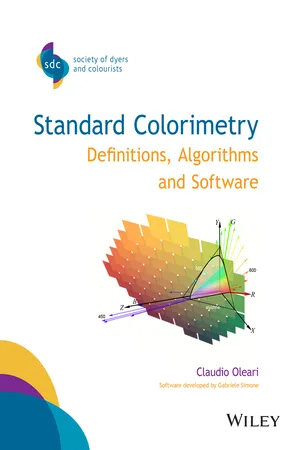
- English
- ePUB (mobile friendly)
- Available on iOS & Android
About This Book
Colour is a sensation and as such it is a subjective and incommunicable quantity. Colour measurement is possible because we can create a correspondence between colour sensations and the light radiations that stimulate them. This correspondence concerns the physics of light radiation, the physiology of the visual process and the psychology of vision.
Historically, in parallel to standard colorimetry, systems for colour ordering have been developed that allow colour specifications in a very practical and concrete way, based on the direct vision of material colour samples arranged in colour atlases. Colour-ordering systems are sources of knowledge of colour vision, which integrate standard colorimetry.
Standard Colorimetry: Definitions, Algorithms and Software:
- Describes physiology and psychophysics useful to understand colorimetry
- Considers all the photometric and colorimetric systems standardized by CIE ( XYZ, CIELAB, CIELUV, LMS )
- Presents colorimetric instrumentation in order to guide the reader toward colorimetric practice
- Discusses colorimetric computation to understand the meaning of numerical colour specification
- Considers colorimetry in colour syntheses and in imaging colour reproduction
- Includes ready-to-use, freely-available software, "Colorimetric eXercise", which has multiple toolboxes dedicated to
- displaying CIE systems, atlases, any colour and its whole numerical specification
- colour-vision phenomena and tests
Standard Colorimetry: Definitions, Algorithms and Software is an accessible and valuable resource for students, lecturers, researchers and laboratory technicians in colour science and image technology.
Follow this link to download the free software "Colorimetric eXercise": http://booksupport.wiley.com/
Standard Colorimetry: Definitions, Algorithms and Software is published in partnership with the Society of Dyers and Colourists (SDC). Find out more at www.wiley.com/go/sdc
Frequently asked questions
Information
1
Generalities on Colour and Colorimetry
1.1 Colour
- Colour of an object – aspect of object appearance distinct from form, shape, size, position, or gloss that depends upon the spectral composition of the incident light, the spectral reflectance or transmittance of the object, and the spectral response of the observer, as well as the illuminating and viewing geometry.”5
- Prceived colour – attribute of visual perception that can be described by colour names such as white, grey, black, yellow, brown, vivid red, deep reddish purple, or by combinations of such names. Discussion – perceived colour depends greatly on the spectral power distribution of the colour stimulus, but also on the size, shape, structure, and surround of the stimulus area, the state of adaptation of the observer’s visual system, and the observer’s experience with similar observations.”5
1.2 Colorimetry
Table of contents
- Cover
- Series
- Title page
- Copyright
- Dedication
- Society of Dyers and Colourists
- Preface
- 1 Generalities on Colour and Colorimetry
- 2 Optics for Colour Stimulus
- 3 Colour and Light-Matter Interaction
- 4 Perceptual Phenomenology of Light and Colour
- 5 Visual System
- 6 Colour-Vision Psychophysics
- 7 CIE Standard Photometry
- 8 Light Sources and Illuminants for Colorimetry
- 9 CIE Standard Psychophysical Observers and Systems
- 10 Chromaticity Diagram from Newton to the CIE 1931 Standard System
- 11 CIE Standard Psychometric Systems
- 12 Instruments and Colorimetric Computation
- 13 Basic Instrumentation for Radiometry, Photometry and Colorimetry
- 14 Colour-Order Systems and Atlases
- 15 Additive Colour Synthesis in Images
- 16 Software
- Index
- Advert
- EULA